Analysis of Contract and Negligence in Business Law: Case Studies
VerifiedAdded on 2019/12/04
|13
|4158
|139
Report
AI Summary
This report provides a comprehensive overview of contract and negligence within the context of business law. It begins by outlining the essential elements required for the formation of a valid contract, including offer and acceptance, competent parties, and intention. It then delves into different types of contracts, such as written, oral, unilateral, and bilateral agreements, and examines the impact of each type. The report also explores various terms within a contract, including expressed, implied, and innominate terms. Furthermore, the report presents and analyzes several case scenarios involving contract law and negligence, such as Ivan and Todor, Adam and Brian, and Barry and the Local council. The report also contrasts contractual and tort liability, detailing the nature of liability in negligence and employer's liability, and provides concluding remarks.
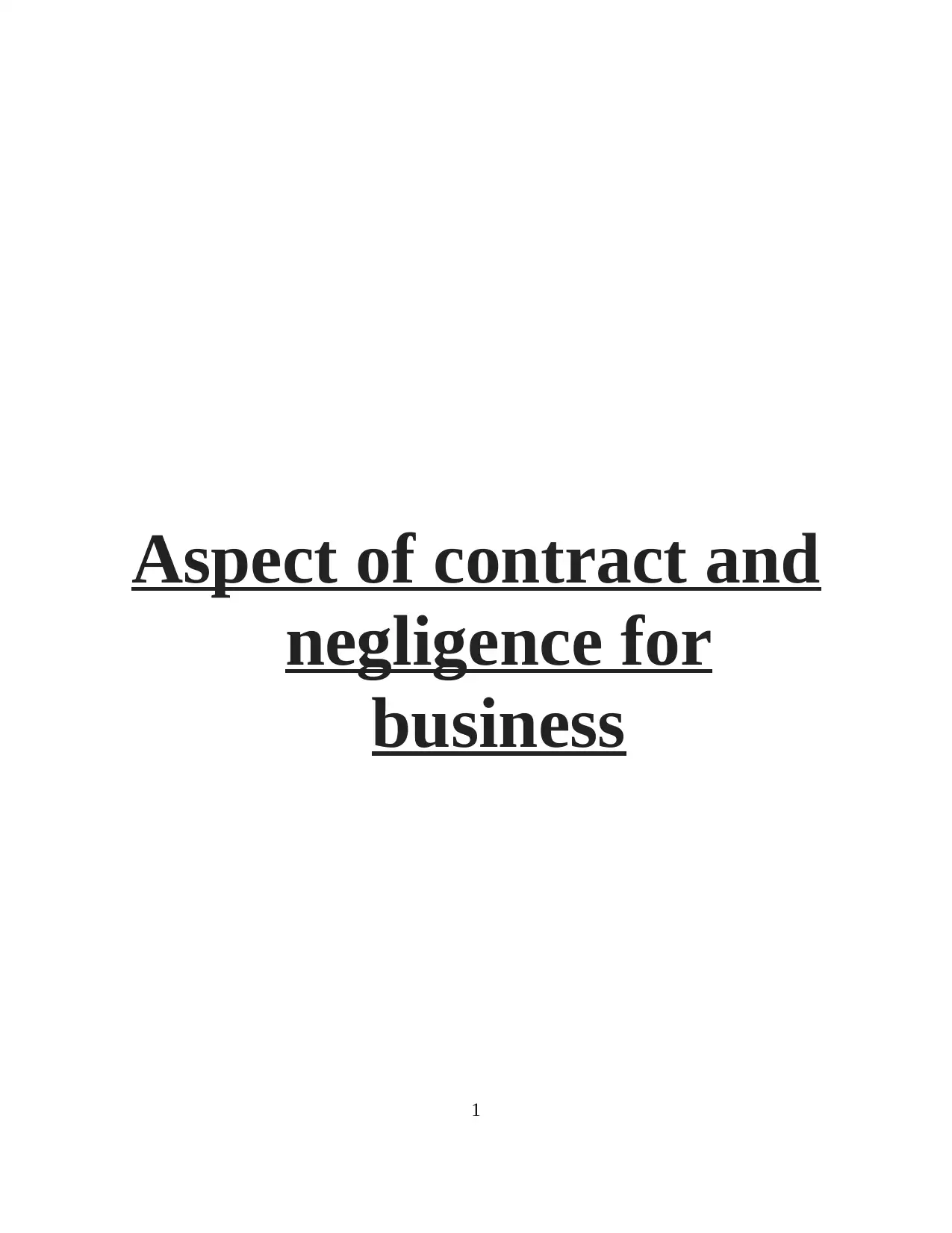
Aspect of contract and
negligence for
business
1
negligence for
business
1
Paraphrase This Document
Need a fresh take? Get an instant paraphrase of this document with our AI Paraphraser
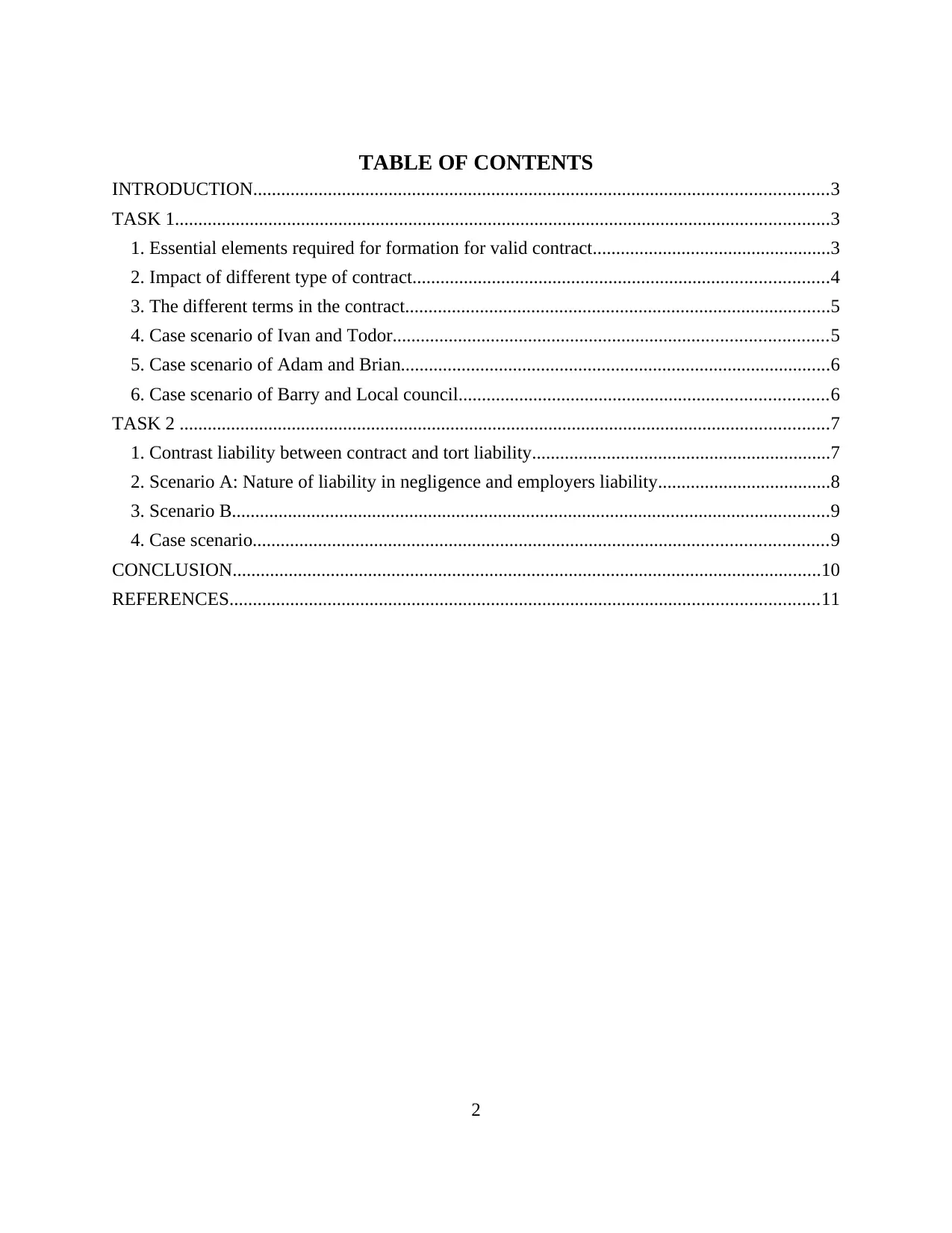
TABLE OF CONTENTS
INTRODUCTION...........................................................................................................................3
TASK 1............................................................................................................................................3
1. Essential elements required for formation for valid contract...................................................3
2. Impact of different type of contract.........................................................................................4
3. The different terms in the contract...........................................................................................5
4. Case scenario of Ivan and Todor.............................................................................................5
5. Case scenario of Adam and Brian............................................................................................6
6. Case scenario of Barry and Local council...............................................................................6
TASK 2 ...........................................................................................................................................7
1. Contrast liability between contract and tort liability................................................................7
2. Scenario A: Nature of liability in negligence and employers liability.....................................8
3. Scenario B................................................................................................................................9
4. Case scenario...........................................................................................................................9
CONCLUSION..............................................................................................................................10
REFERENCES..............................................................................................................................11
2
INTRODUCTION...........................................................................................................................3
TASK 1............................................................................................................................................3
1. Essential elements required for formation for valid contract...................................................3
2. Impact of different type of contract.........................................................................................4
3. The different terms in the contract...........................................................................................5
4. Case scenario of Ivan and Todor.............................................................................................5
5. Case scenario of Adam and Brian............................................................................................6
6. Case scenario of Barry and Local council...............................................................................6
TASK 2 ...........................................................................................................................................7
1. Contrast liability between contract and tort liability................................................................7
2. Scenario A: Nature of liability in negligence and employers liability.....................................8
3. Scenario B................................................................................................................................9
4. Case scenario...........................................................................................................................9
CONCLUSION..............................................................................................................................10
REFERENCES..............................................................................................................................11
2
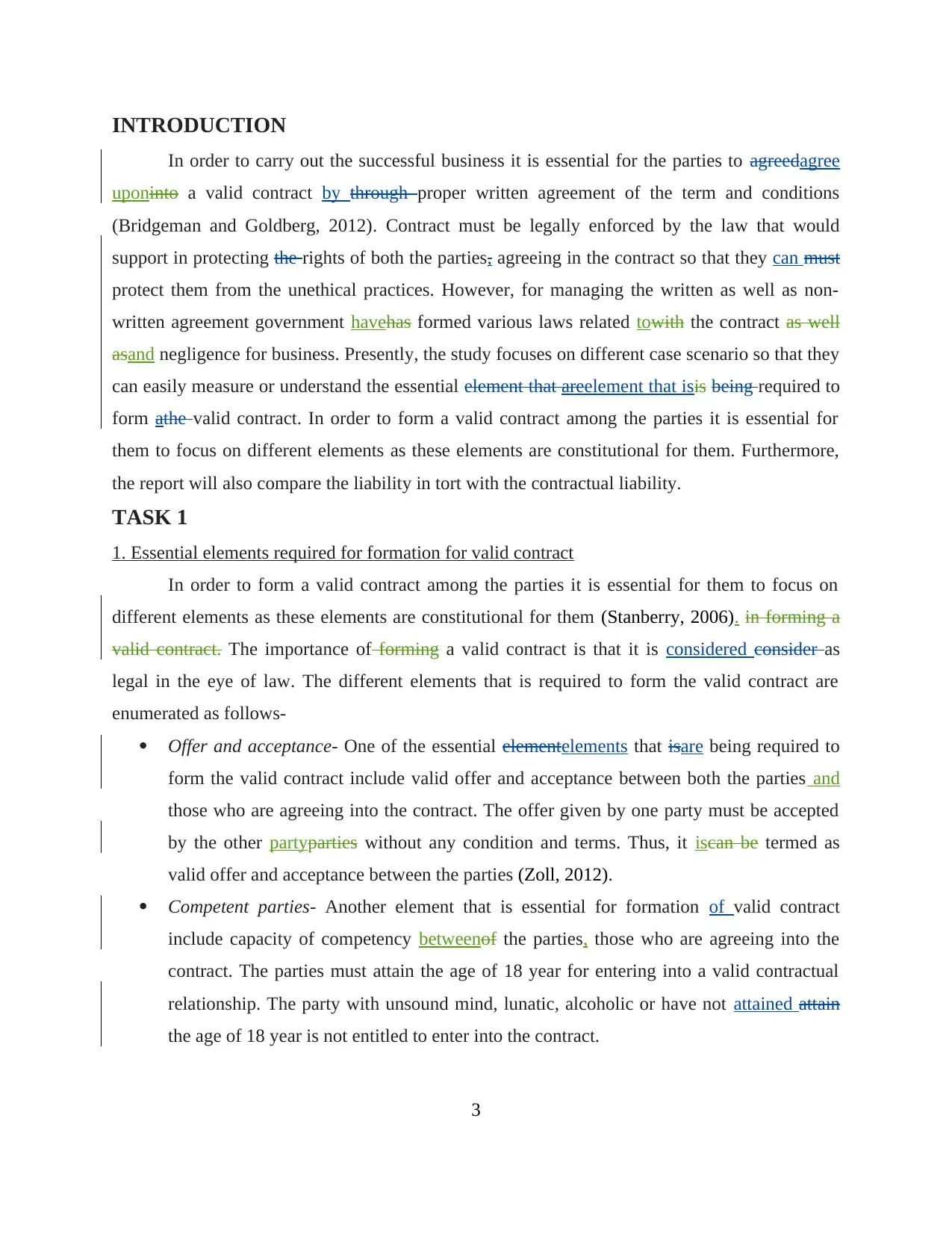
INTRODUCTION
In order to carry out the successful business it is essential for the parties to agreedagree
uponinto a valid contract by through proper written agreement of the term and conditions
(Bridgeman and Goldberg, 2012). Contract must be legally enforced by the law that would
support in protecting the rights of both the parties, agreeing in the contract so that they can must
protect them from the unethical practices. However, for managing the written as well as non-
written agreement government havehas formed various laws related towith the contract as well
asand negligence for business. Presently, the study focuses on different case scenario so that they
can easily measure or understand the essential element that areelement that isis being required to
form athe valid contract. In order to form a valid contract among the parties it is essential for
them to focus on different elements as these elements are constitutional for them. Furthermore,
the report will also compare the liability in tort with the contractual liability.
TASK 1
1. Essential elements required for formation for valid contract
In order to form a valid contract among the parties it is essential for them to focus on
different elements as these elements are constitutional for them (Stanberry, 2006). in forming a
valid contract. The importance of forming a valid contract is that it is considered consider as
legal in the eye of law. The different elements that is required to form the valid contract are
enumerated as follows-
Offer and acceptance- One of the essential elementelements that isare being required to
form the valid contract include valid offer and acceptance between both the parties and
those who are agreeing into the contract. The offer given by one party must be accepted
by the other partyparties without any condition and terms. Thus, it iscan be termed as
valid offer and acceptance between the parties (Zoll, 2012).
Competent parties- Another element that is essential for formation of valid contract
include capacity of competency betweenof the parties, those who are agreeing into the
contract. The parties must attain the age of 18 year for entering into a valid contractual
relationship. The party with unsound mind, lunatic, alcoholic or have not attained attain
the age of 18 year is not entitled to enter into the contract.
3
In order to carry out the successful business it is essential for the parties to agreedagree
uponinto a valid contract by through proper written agreement of the term and conditions
(Bridgeman and Goldberg, 2012). Contract must be legally enforced by the law that would
support in protecting the rights of both the parties, agreeing in the contract so that they can must
protect them from the unethical practices. However, for managing the written as well as non-
written agreement government havehas formed various laws related towith the contract as well
asand negligence for business. Presently, the study focuses on different case scenario so that they
can easily measure or understand the essential element that areelement that isis being required to
form athe valid contract. In order to form a valid contract among the parties it is essential for
them to focus on different elements as these elements are constitutional for them. Furthermore,
the report will also compare the liability in tort with the contractual liability.
TASK 1
1. Essential elements required for formation for valid contract
In order to form a valid contract among the parties it is essential for them to focus on
different elements as these elements are constitutional for them (Stanberry, 2006). in forming a
valid contract. The importance of forming a valid contract is that it is considered consider as
legal in the eye of law. The different elements that is required to form the valid contract are
enumerated as follows-
Offer and acceptance- One of the essential elementelements that isare being required to
form the valid contract include valid offer and acceptance between both the parties and
those who are agreeing into the contract. The offer given by one party must be accepted
by the other partyparties without any condition and terms. Thus, it iscan be termed as
valid offer and acceptance between the parties (Zoll, 2012).
Competent parties- Another element that is essential for formation of valid contract
include capacity of competency betweenof the parties, those who are agreeing into the
contract. The parties must attain the age of 18 year for entering into a valid contractual
relationship. The party with unsound mind, lunatic, alcoholic or have not attained attain
the age of 18 year is not entitled to enter into the contract.
3
⊘ This is a preview!⊘
Do you want full access?
Subscribe today to unlock all pages.

Trusted by 1+ million students worldwide
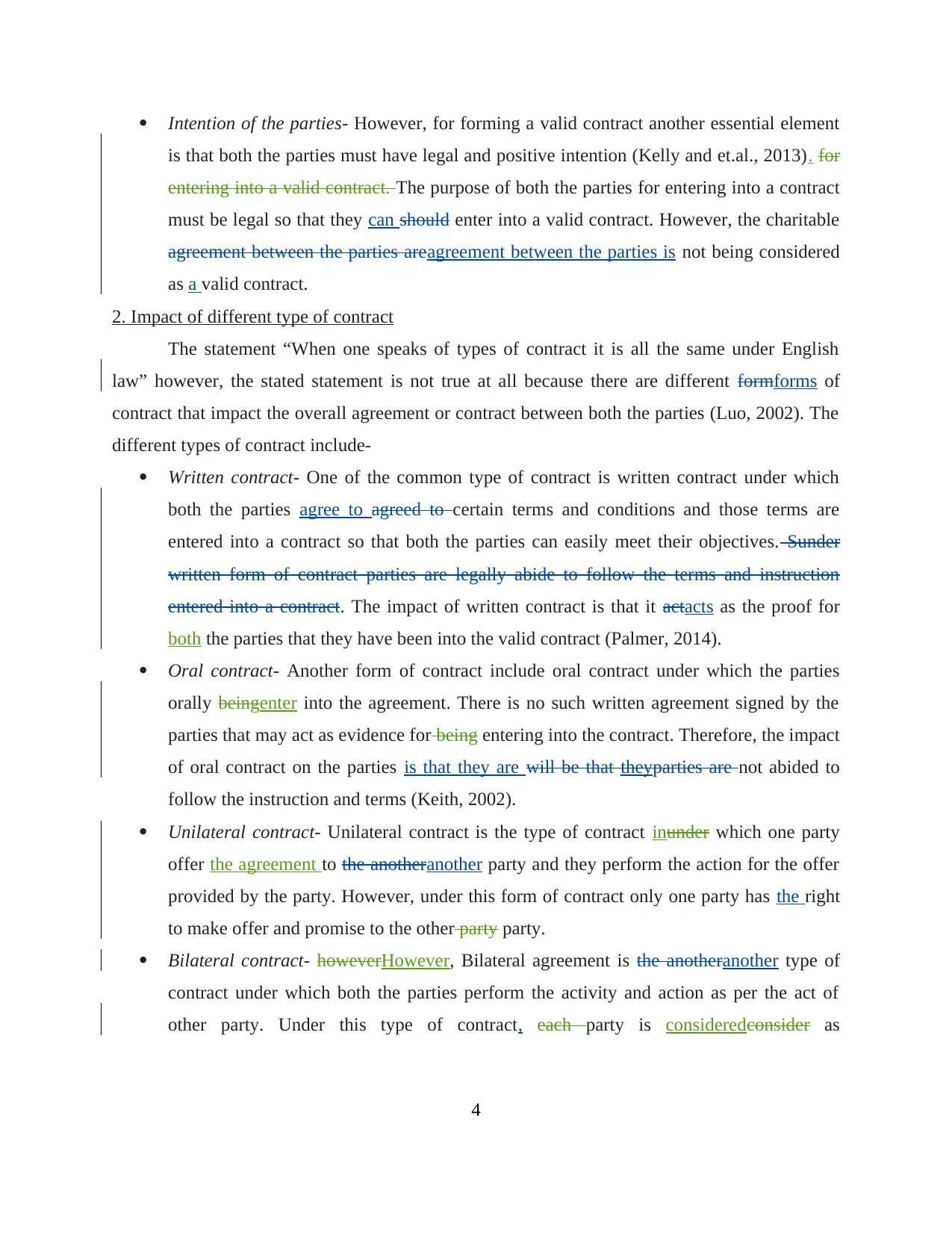
Intention of the parties- However, for forming a valid contract another essential element
is that both the parties must have legal and positive intention (Kelly and et.al., 2013). for
entering into a valid contract. The purpose of both the parties for entering into a contract
must be legal so that they can should enter into a valid contract. However, the charitable
agreement between the parties areagreement between the parties is not being considered
as a valid contract.
2. Impact of different type of contract
The statement “When one speaks of types of contract it is all the same under English
law” however, the stated statement is not true at all because there are different formforms of
contract that impact the overall agreement or contract between both the parties (Luo, 2002). The
different types of contract include-
Written contract- One of the common type of contract is written contract under which
both the parties agree to agreed to certain terms and conditions and those terms are
entered into a contract so that both the parties can easily meet their objectives. Sunder
written form of contract parties are legally abide to follow the terms and instruction
entered into a contract. The impact of written contract is that it actacts as the proof for
both the parties that they have been into the valid contract (Palmer, 2014).
Oral contract- Another form of contract include oral contract under which the parties
orally beingenter into the agreement. There is no such written agreement signed by the
parties that may act as evidence for being entering into the contract. Therefore, the impact
of oral contract on the parties is that they are will be that theyparties are not abided to
follow the instruction and terms (Keith, 2002).
Unilateral contract- Unilateral contract is the type of contract inunder which one party
offer the agreement to the anotheranother party and they perform the action for the offer
provided by the party. However, under this form of contract only one party has the right
to make offer and promise to the other party party.
Bilateral contract- howeverHowever, Bilateral agreement is the anotheranother type of
contract under which both the parties perform the activity and action as per the act of
other party. Under this type of contract, each party is consideredconsider as
4
is that both the parties must have legal and positive intention (Kelly and et.al., 2013). for
entering into a valid contract. The purpose of both the parties for entering into a contract
must be legal so that they can should enter into a valid contract. However, the charitable
agreement between the parties areagreement between the parties is not being considered
as a valid contract.
2. Impact of different type of contract
The statement “When one speaks of types of contract it is all the same under English
law” however, the stated statement is not true at all because there are different formforms of
contract that impact the overall agreement or contract between both the parties (Luo, 2002). The
different types of contract include-
Written contract- One of the common type of contract is written contract under which
both the parties agree to agreed to certain terms and conditions and those terms are
entered into a contract so that both the parties can easily meet their objectives. Sunder
written form of contract parties are legally abide to follow the terms and instruction
entered into a contract. The impact of written contract is that it actacts as the proof for
both the parties that they have been into the valid contract (Palmer, 2014).
Oral contract- Another form of contract include oral contract under which the parties
orally beingenter into the agreement. There is no such written agreement signed by the
parties that may act as evidence for being entering into the contract. Therefore, the impact
of oral contract on the parties is that they are will be that theyparties are not abided to
follow the instruction and terms (Keith, 2002).
Unilateral contract- Unilateral contract is the type of contract inunder which one party
offer the agreement to the anotheranother party and they perform the action for the offer
provided by the party. However, under this form of contract only one party has the right
to make offer and promise to the other party party.
Bilateral contract- howeverHowever, Bilateral agreement is the anotheranother type of
contract under which both the parties perform the activity and action as per the act of
other party. Under this type of contract, each party is consideredconsider as
4
Paraphrase This Document
Need a fresh take? Get an instant paraphrase of this document with our AI Paraphraser
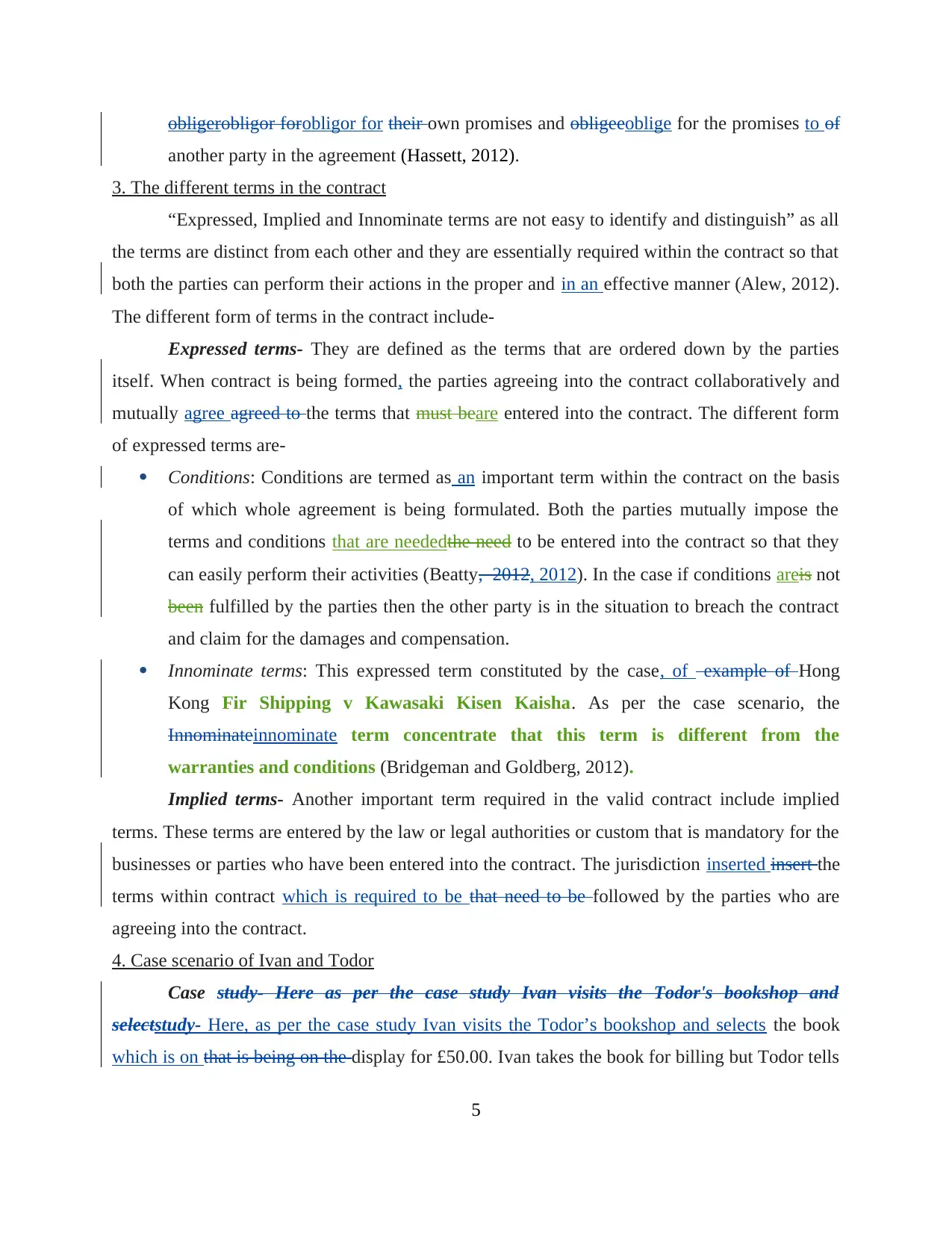
obligerobligor forobligor for their own promises and obligeeoblige for the promises to of
another party in the agreement (Hassett, 2012).
3. The different terms in the contract
“Expressed, Implied and Innominate terms are not easy to identify and distinguish” as all
the terms are distinct from each other and they are essentially required within the contract so that
both the parties can perform their actions in the proper and in an effective manner (Alew, 2012).
The different form of terms in the contract include-
Expressed terms- They are defined as the terms that are ordered down by the parties
itself. When contract is being formed, the parties agreeing into the contract collaboratively and
mutually agree agreed to the terms that must beare entered into the contract. The different form
of expressed terms are-
Conditions: Conditions are termed as an important term within the contract on the basis
of which whole agreement is being formulated. Both the parties mutually impose the
terms and conditions that are neededthe need to be entered into the contract so that they
can easily perform their activities (Beatty, 2012, 2012). In the case if conditions areis not
been fulfilled by the parties then the other party is in the situation to breach the contract
and claim for the damages and compensation.
Innominate terms: This expressed term constituted by the case, of example of Hong
Kong Fir Shipping v Kawasaki Kisen Kaisha. As per the case scenario, the
Innominateinnominate term concentrate that this term is different from the
warranties and conditions (Bridgeman and Goldberg, 2012).
Implied terms- Another important term required in the valid contract include implied
terms. These terms are entered by the law or legal authorities or custom that is mandatory for the
businesses or parties who have been entered into the contract. The jurisdiction inserted insert the
terms within contract which is required to be that need to be followed by the parties who are
agreeing into the contract.
4. Case scenario of Ivan and Todor
Case study- Here as per the case study Ivan visits the Todor's bookshop and
selectstudy- Here, as per the case study Ivan visits the Todor’s bookshop and selects the book
which is on that is being on the display for £50.00. Ivan takes the book for billing but Todor tells
5
another party in the agreement (Hassett, 2012).
3. The different terms in the contract
“Expressed, Implied and Innominate terms are not easy to identify and distinguish” as all
the terms are distinct from each other and they are essentially required within the contract so that
both the parties can perform their actions in the proper and in an effective manner (Alew, 2012).
The different form of terms in the contract include-
Expressed terms- They are defined as the terms that are ordered down by the parties
itself. When contract is being formed, the parties agreeing into the contract collaboratively and
mutually agree agreed to the terms that must beare entered into the contract. The different form
of expressed terms are-
Conditions: Conditions are termed as an important term within the contract on the basis
of which whole agreement is being formulated. Both the parties mutually impose the
terms and conditions that are neededthe need to be entered into the contract so that they
can easily perform their activities (Beatty, 2012, 2012). In the case if conditions areis not
been fulfilled by the parties then the other party is in the situation to breach the contract
and claim for the damages and compensation.
Innominate terms: This expressed term constituted by the case, of example of Hong
Kong Fir Shipping v Kawasaki Kisen Kaisha. As per the case scenario, the
Innominateinnominate term concentrate that this term is different from the
warranties and conditions (Bridgeman and Goldberg, 2012).
Implied terms- Another important term required in the valid contract include implied
terms. These terms are entered by the law or legal authorities or custom that is mandatory for the
businesses or parties who have been entered into the contract. The jurisdiction inserted insert the
terms within contract which is required to be that need to be followed by the parties who are
agreeing into the contract.
4. Case scenario of Ivan and Todor
Case study- Here as per the case study Ivan visits the Todor's bookshop and
selectstudy- Here, as per the case study Ivan visits the Todor’s bookshop and selects the book
which is on that is being on the display for £50.00. Ivan takes the book for billing but Todor tells
5
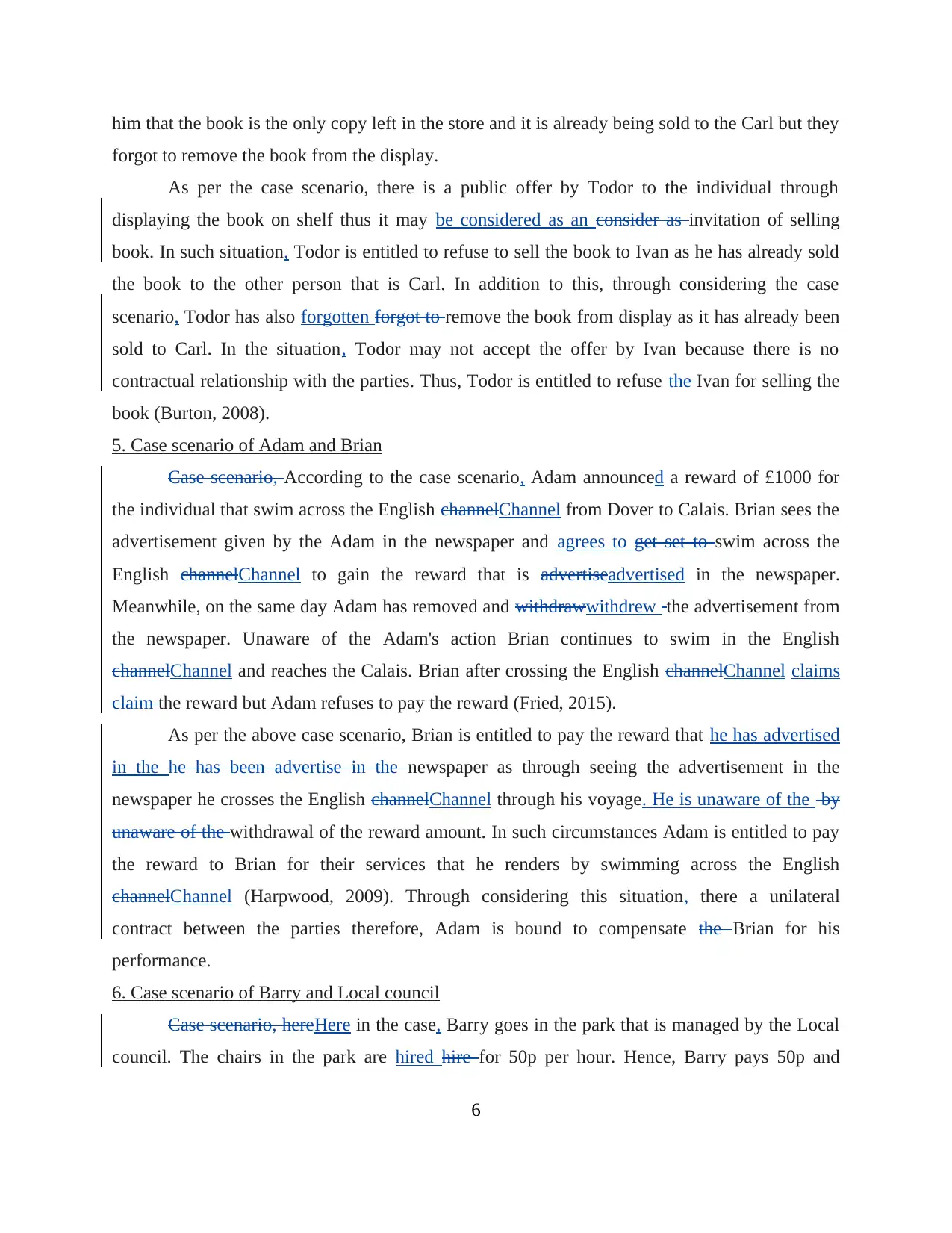
him that the book is the only copy left in the store and it is already being sold to the Carl but they
forgot to remove the book from the display.
As per the case scenario, there is a public offer by Todor to the individual through
displaying the book on shelf thus it may be considered as an consider as invitation of selling
book. In such situation, Todor is entitled to refuse to sell the book to Ivan as he has already sold
the book to the other person that is Carl. In addition to this, through considering the case
scenario, Todor has also forgotten forgot to remove the book from display as it has already been
sold to Carl. In the situation, Todor may not accept the offer by Ivan because there is no
contractual relationship with the parties. Thus, Todor is entitled to refuse the Ivan for selling the
book (Burton, 2008).
5. Case scenario of Adam and Brian
Case scenario, According to the case scenario, Adam announced a reward of £1000 for
the individual that swim across the English channelChannel from Dover to Calais. Brian sees the
advertisement given by the Adam in the newspaper and agrees to get set to swim across the
English channelChannel to gain the reward that is advertiseadvertised in the newspaper.
Meanwhile, on the same day Adam has removed and withdrawwithdrew the advertisement from
the newspaper. Unaware of the Adam's action Brian continues to swim in the English
channelChannel and reaches the Calais. Brian after crossing the English channelChannel claims
claim the reward but Adam refuses to pay the reward (Fried, 2015).
As per the above case scenario, Brian is entitled to pay the reward that he has advertised
in the he has been advertise in the newspaper as through seeing the advertisement in the
newspaper he crosses the English channelChannel through his voyage. He is unaware of the by
unaware of the withdrawal of the reward amount. In such circumstances Adam is entitled to pay
the reward to Brian for their services that he renders by swimming across the English
channelChannel (Harpwood, 2009). Through considering this situation, there a unilateral
contract between the parties therefore, Adam is bound to compensate the Brian for his
performance.
6. Case scenario of Barry and Local council
Case scenario, hereHere in the case, Barry goes in the park that is managed by the Local
council. The chairs in the park are hired hire for 50p per hour. Hence, Barry pays 50p and
6
forgot to remove the book from the display.
As per the case scenario, there is a public offer by Todor to the individual through
displaying the book on shelf thus it may be considered as an consider as invitation of selling
book. In such situation, Todor is entitled to refuse to sell the book to Ivan as he has already sold
the book to the other person that is Carl. In addition to this, through considering the case
scenario, Todor has also forgotten forgot to remove the book from display as it has already been
sold to Carl. In the situation, Todor may not accept the offer by Ivan because there is no
contractual relationship with the parties. Thus, Todor is entitled to refuse the Ivan for selling the
book (Burton, 2008).
5. Case scenario of Adam and Brian
Case scenario, According to the case scenario, Adam announced a reward of £1000 for
the individual that swim across the English channelChannel from Dover to Calais. Brian sees the
advertisement given by the Adam in the newspaper and agrees to get set to swim across the
English channelChannel to gain the reward that is advertiseadvertised in the newspaper.
Meanwhile, on the same day Adam has removed and withdrawwithdrew the advertisement from
the newspaper. Unaware of the Adam's action Brian continues to swim in the English
channelChannel and reaches the Calais. Brian after crossing the English channelChannel claims
claim the reward but Adam refuses to pay the reward (Fried, 2015).
As per the above case scenario, Brian is entitled to pay the reward that he has advertised
in the he has been advertise in the newspaper as through seeing the advertisement in the
newspaper he crosses the English channelChannel through his voyage. He is unaware of the by
unaware of the withdrawal of the reward amount. In such circumstances Adam is entitled to pay
the reward to Brian for their services that he renders by swimming across the English
channelChannel (Harpwood, 2009). Through considering this situation, there a unilateral
contract between the parties therefore, Adam is bound to compensate the Brian for his
performance.
6. Case scenario of Barry and Local council
Case scenario, hereHere in the case, Barry goes in the park that is managed by the Local
council. The chairs in the park are hired hire for 50p per hour. Hence, Barry pays 50p and
6
⊘ This is a preview!⊘
Do you want full access?
Subscribe today to unlock all pages.

Trusted by 1+ million students worldwide
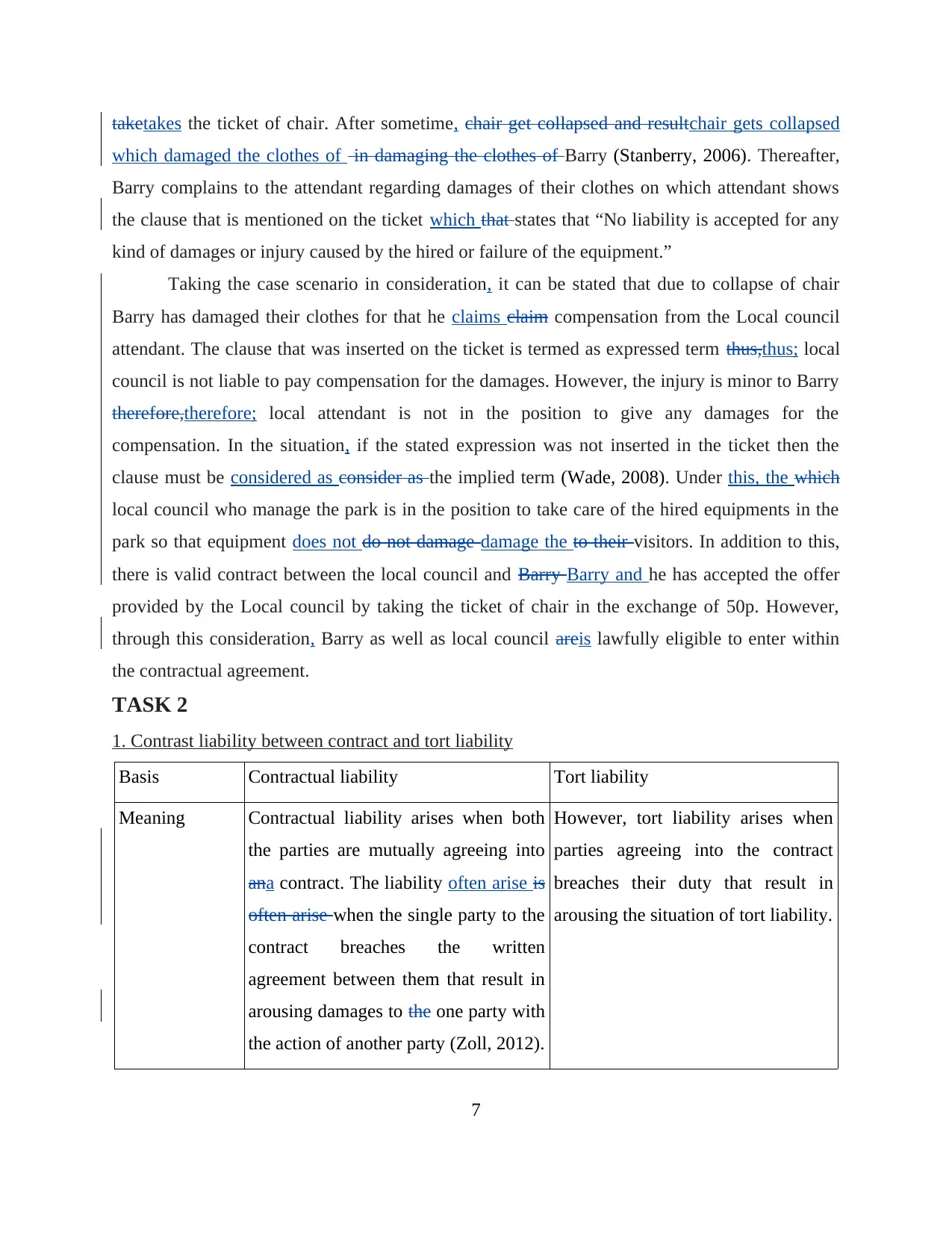
taketakes the ticket of chair. After sometime, chair get collapsed and resultchair gets collapsed
which damaged the clothes of in damaging the clothes of Barry (Stanberry, 2006). Thereafter,
Barry complains to the attendant regarding damages of their clothes on which attendant shows
the clause that is mentioned on the ticket which that states that “No liability is accepted for any
kind of damages or injury caused by the hired or failure of the equipment.”
Taking the case scenario in consideration, it can be stated that due to collapse of chair
Barry has damaged their clothes for that he claims claim compensation from the Local council
attendant. The clause that was inserted on the ticket is termed as expressed term thus,thus; local
council is not liable to pay compensation for the damages. However, the injury is minor to Barry
therefore,therefore; local attendant is not in the position to give any damages for the
compensation. In the situation, if the stated expression was not inserted in the ticket then the
clause must be considered as consider as the implied term (Wade, 2008). Under this, the which
local council who manage the park is in the position to take care of the hired equipments in the
park so that equipment does not do not damage damage the to their visitors. In addition to this,
there is valid contract between the local council and Barry Barry and he has accepted the offer
provided by the Local council by taking the ticket of chair in the exchange of 50p. However,
through this consideration, Barry as well as local council areis lawfully eligible to enter within
the contractual agreement.
TASK 2
1. Contrast liability between contract and tort liability
Basis Contractual liability Tort liability
Meaning Contractual liability arises when both
the parties are mutually agreeing into
ana contract. The liability often arise is
often arise when the single party to the
contract breaches the written
agreement between them that result in
arousing damages to the one party with
the action of another party (Zoll, 2012).
However, tort liability arises when
parties agreeing into the contract
breaches their duty that result in
arousing the situation of tort liability.
7
which damaged the clothes of in damaging the clothes of Barry (Stanberry, 2006). Thereafter,
Barry complains to the attendant regarding damages of their clothes on which attendant shows
the clause that is mentioned on the ticket which that states that “No liability is accepted for any
kind of damages or injury caused by the hired or failure of the equipment.”
Taking the case scenario in consideration, it can be stated that due to collapse of chair
Barry has damaged their clothes for that he claims claim compensation from the Local council
attendant. The clause that was inserted on the ticket is termed as expressed term thus,thus; local
council is not liable to pay compensation for the damages. However, the injury is minor to Barry
therefore,therefore; local attendant is not in the position to give any damages for the
compensation. In the situation, if the stated expression was not inserted in the ticket then the
clause must be considered as consider as the implied term (Wade, 2008). Under this, the which
local council who manage the park is in the position to take care of the hired equipments in the
park so that equipment does not do not damage damage the to their visitors. In addition to this,
there is valid contract between the local council and Barry Barry and he has accepted the offer
provided by the Local council by taking the ticket of chair in the exchange of 50p. However,
through this consideration, Barry as well as local council areis lawfully eligible to enter within
the contractual agreement.
TASK 2
1. Contrast liability between contract and tort liability
Basis Contractual liability Tort liability
Meaning Contractual liability arises when both
the parties are mutually agreeing into
ana contract. The liability often arise is
often arise when the single party to the
contract breaches the written
agreement between them that result in
arousing damages to the one party with
the action of another party (Zoll, 2012).
However, tort liability arises when
parties agreeing into the contract
breaches their duty that result in
arousing the situation of tort liability.
7
Paraphrase This Document
Need a fresh take? Get an instant paraphrase of this document with our AI Paraphraser
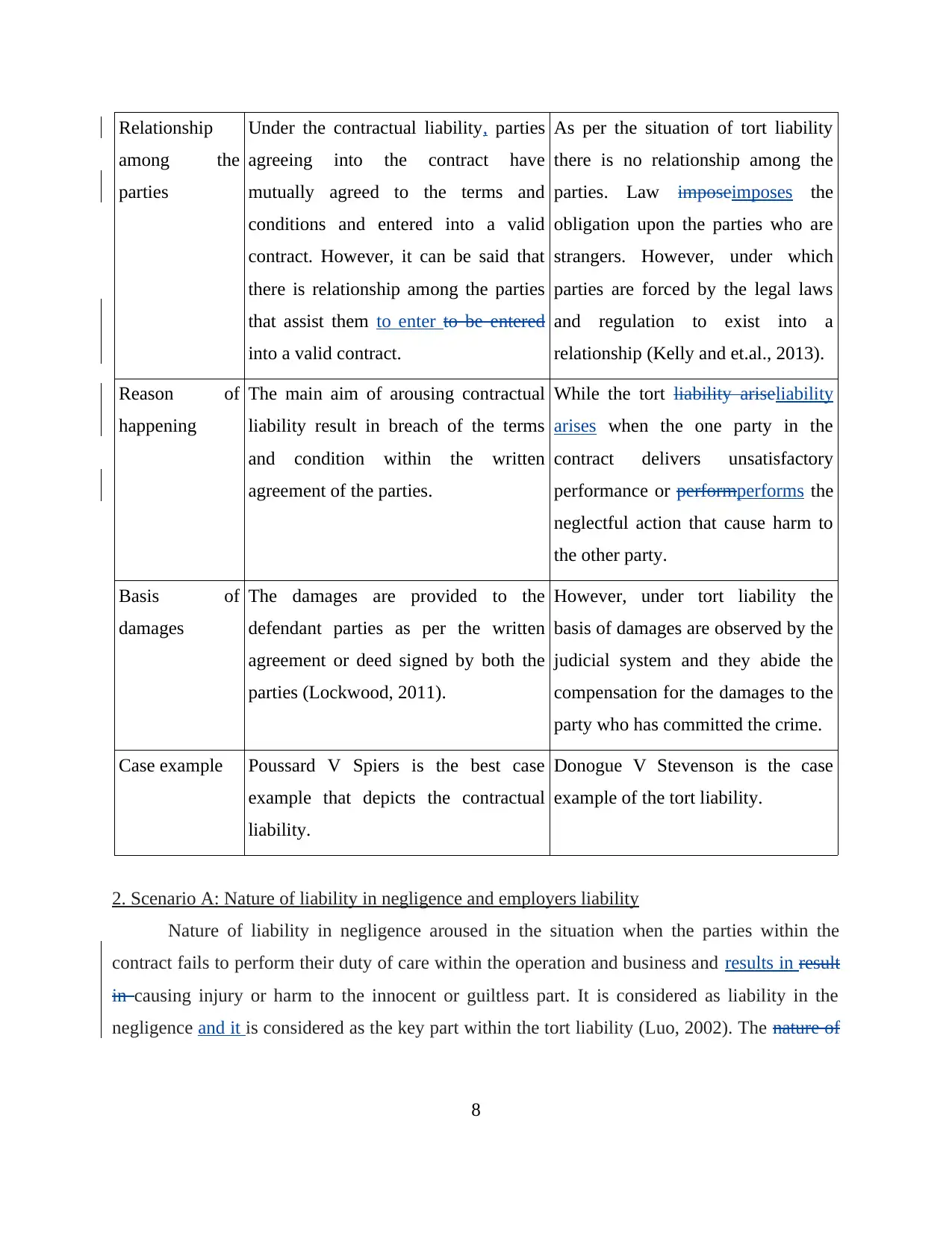
Relationship
among the
parties
Under the contractual liability, parties
agreeing into the contract have
mutually agreed to the terms and
conditions and entered into a valid
contract. However, it can be said that
there is relationship among the parties
that assist them to enter to be entered
into a valid contract.
As per the situation of tort liability
there is no relationship among the
parties. Law imposeimposes the
obligation upon the parties who are
strangers. However, under which
parties are forced by the legal laws
and regulation to exist into a
relationship (Kelly and et.al., 2013).
Reason of
happening
The main aim of arousing contractual
liability result in breach of the terms
and condition within the written
agreement of the parties.
While the tort liability ariseliability
arises when the one party in the
contract delivers unsatisfactory
performance or performperforms the
neglectful action that cause harm to
the other party.
Basis of
damages
The damages are provided to the
defendant parties as per the written
agreement or deed signed by both the
parties (Lockwood, 2011).
However, under tort liability the
basis of damages are observed by the
judicial system and they abide the
compensation for the damages to the
party who has committed the crime.
Case example Poussard V Spiers is the best case
example that depicts the contractual
liability.
Donogue V Stevenson is the case
example of the tort liability.
2. Scenario A: Nature of liability in negligence and employers liability
Nature of liability in negligence aroused in the situation when the parties within the
contract fails to perform their duty of care within the operation and business and results in result
in causing injury or harm to the innocent or guiltless part. It is considered as liability in the
negligence and it is considered as the key part within the tort liability (Luo, 2002). The nature of
8
among the
parties
Under the contractual liability, parties
agreeing into the contract have
mutually agreed to the terms and
conditions and entered into a valid
contract. However, it can be said that
there is relationship among the parties
that assist them to enter to be entered
into a valid contract.
As per the situation of tort liability
there is no relationship among the
parties. Law imposeimposes the
obligation upon the parties who are
strangers. However, under which
parties are forced by the legal laws
and regulation to exist into a
relationship (Kelly and et.al., 2013).
Reason of
happening
The main aim of arousing contractual
liability result in breach of the terms
and condition within the written
agreement of the parties.
While the tort liability ariseliability
arises when the one party in the
contract delivers unsatisfactory
performance or performperforms the
neglectful action that cause harm to
the other party.
Basis of
damages
The damages are provided to the
defendant parties as per the written
agreement or deed signed by both the
parties (Lockwood, 2011).
However, under tort liability the
basis of damages are observed by the
judicial system and they abide the
compensation for the damages to the
party who has committed the crime.
Case example Poussard V Spiers is the best case
example that depicts the contractual
liability.
Donogue V Stevenson is the case
example of the tort liability.
2. Scenario A: Nature of liability in negligence and employers liability
Nature of liability in negligence aroused in the situation when the parties within the
contract fails to perform their duty of care within the operation and business and results in result
in causing injury or harm to the innocent or guiltless part. It is considered as liability in the
negligence and it is considered as the key part within the tort liability (Luo, 2002). The nature of
8
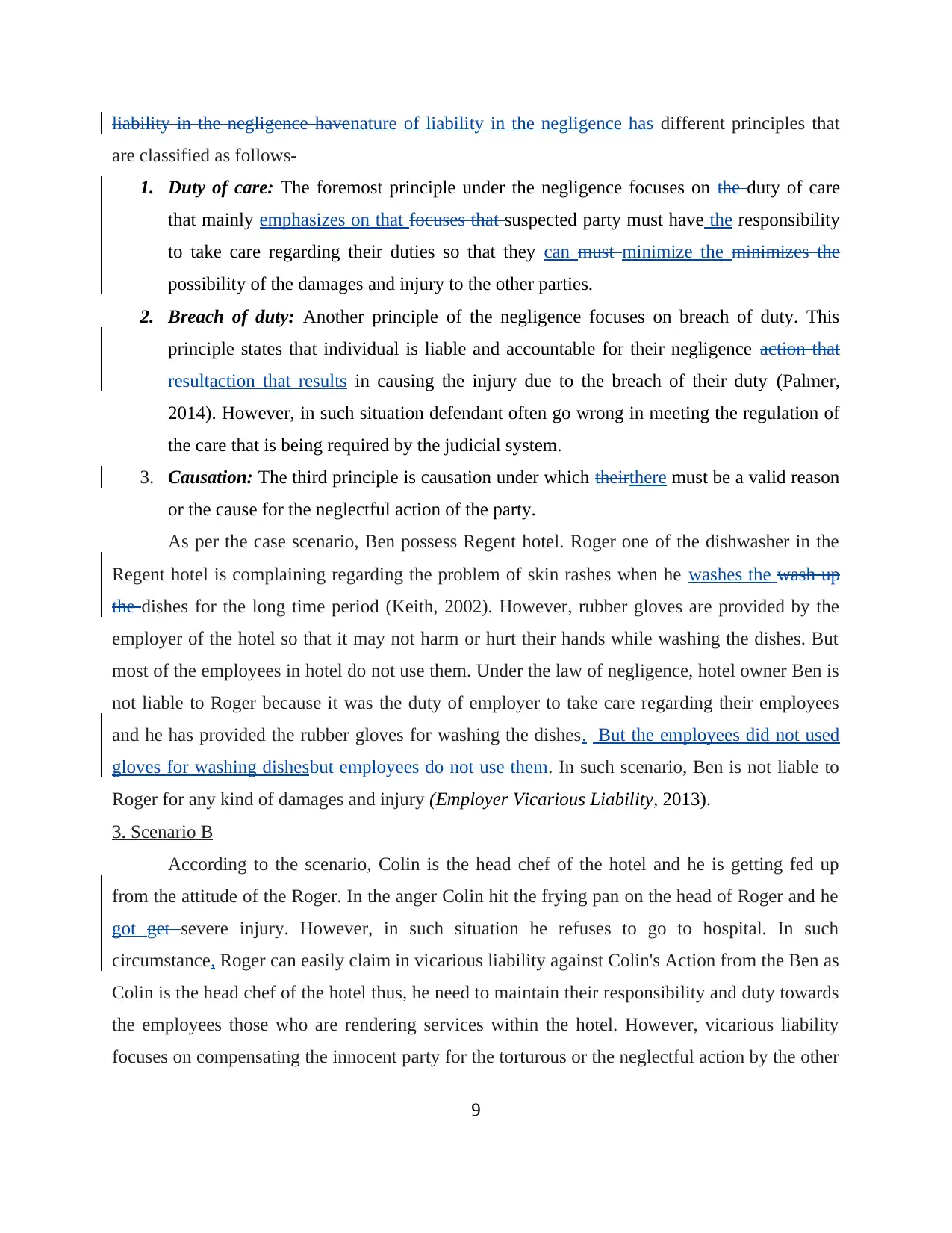
liability in the negligence havenature of liability in the negligence has different principles that
are classified as follows-
1. Duty of care: The foremost principle under the negligence focuses on the duty of care
that mainly emphasizes on that focuses that suspected party must have the responsibility
to take care regarding their duties so that they can must minimize the minimizes the
possibility of the damages and injury to the other parties.
2. Breach of duty: Another principle of the negligence focuses on breach of duty. This
principle states that individual is liable and accountable for their negligence action that
resultaction that results in causing the injury due to the breach of their duty (Palmer,
2014). However, in such situation defendant often go wrong in meeting the regulation of
the care that is being required by the judicial system.
3. Causation: The third principle is causation under which theirthere must be a valid reason
or the cause for the neglectful action of the party.
As per the case scenario, Ben possess Regent hotel. Roger one of the dishwasher in the
Regent hotel is complaining regarding the problem of skin rashes when he washes the wash up
the dishes for the long time period (Keith, 2002). However, rubber gloves are provided by the
employer of the hotel so that it may not harm or hurt their hands while washing the dishes. But
most of the employees in hotel do not use them. Under the law of negligence, hotel owner Ben is
not liable to Roger because it was the duty of employer to take care regarding their employees
and he has provided the rubber gloves for washing the dishes. But the employees did not used
gloves for washing dishesbut employees do not use them. In such scenario, Ben is not liable to
Roger for any kind of damages and injury (Employer Vicarious Liability, 2013).
3. Scenario B
According to the scenario, Colin is the head chef of the hotel and he is getting fed up
from the attitude of the Roger. In the anger Colin hit the frying pan on the head of Roger and he
got get severe injury. However, in such situation he refuses to go to hospital. In such
circumstance, Roger can easily claim in vicarious liability against Colin's Action from the Ben as
Colin is the head chef of the hotel thus, he need to maintain their responsibility and duty towards
the employees those who are rendering services within the hotel. However, vicarious liability
focuses on compensating the innocent party for the torturous or the neglectful action by the other
9
are classified as follows-
1. Duty of care: The foremost principle under the negligence focuses on the duty of care
that mainly emphasizes on that focuses that suspected party must have the responsibility
to take care regarding their duties so that they can must minimize the minimizes the
possibility of the damages and injury to the other parties.
2. Breach of duty: Another principle of the negligence focuses on breach of duty. This
principle states that individual is liable and accountable for their negligence action that
resultaction that results in causing the injury due to the breach of their duty (Palmer,
2014). However, in such situation defendant often go wrong in meeting the regulation of
the care that is being required by the judicial system.
3. Causation: The third principle is causation under which theirthere must be a valid reason
or the cause for the neglectful action of the party.
As per the case scenario, Ben possess Regent hotel. Roger one of the dishwasher in the
Regent hotel is complaining regarding the problem of skin rashes when he washes the wash up
the dishes for the long time period (Keith, 2002). However, rubber gloves are provided by the
employer of the hotel so that it may not harm or hurt their hands while washing the dishes. But
most of the employees in hotel do not use them. Under the law of negligence, hotel owner Ben is
not liable to Roger because it was the duty of employer to take care regarding their employees
and he has provided the rubber gloves for washing the dishes. But the employees did not used
gloves for washing dishesbut employees do not use them. In such scenario, Ben is not liable to
Roger for any kind of damages and injury (Employer Vicarious Liability, 2013).
3. Scenario B
According to the scenario, Colin is the head chef of the hotel and he is getting fed up
from the attitude of the Roger. In the anger Colin hit the frying pan on the head of Roger and he
got get severe injury. However, in such situation he refuses to go to hospital. In such
circumstance, Roger can easily claim in vicarious liability against Colin's Action from the Ben as
Colin is the head chef of the hotel thus, he need to maintain their responsibility and duty towards
the employees those who are rendering services within the hotel. However, vicarious liability
focuses on compensating the innocent party for the torturous or the neglectful action by the other
9
⊘ This is a preview!⊘
Do you want full access?
Subscribe today to unlock all pages.

Trusted by 1+ million students worldwide
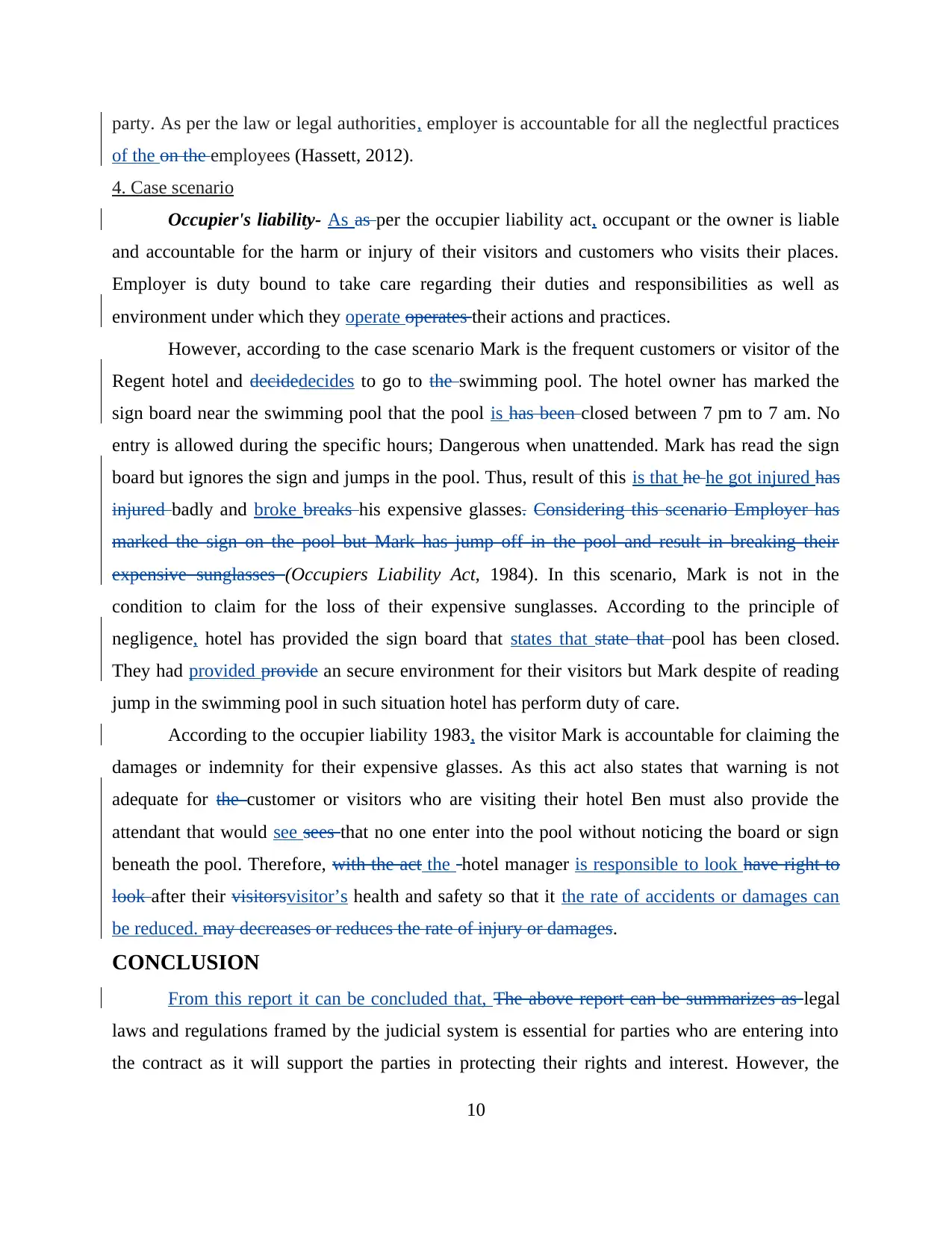
party. As per the law or legal authorities, employer is accountable for all the neglectful practices
of the on the employees (Hassett, 2012).
4. Case scenario
Occupier's liability- As as per the occupier liability act, occupant or the owner is liable
and accountable for the harm or injury of their visitors and customers who visits their places.
Employer is duty bound to take care regarding their duties and responsibilities as well as
environment under which they operate operates their actions and practices.
However, according to the case scenario Mark is the frequent customers or visitor of the
Regent hotel and decidedecides to go to the swimming pool. The hotel owner has marked the
sign board near the swimming pool that the pool is has been closed between 7 pm to 7 am. No
entry is allowed during the specific hours; Dangerous when unattended. Mark has read the sign
board but ignores the sign and jumps in the pool. Thus, result of this is that he he got injured has
injured badly and broke breaks his expensive glasses. Considering this scenario Employer has
marked the sign on the pool but Mark has jump off in the pool and result in breaking their
expensive sunglasses (Occupiers Liability Act, 1984). In this scenario, Mark is not in the
condition to claim for the loss of their expensive sunglasses. According to the principle of
negligence, hotel has provided the sign board that states that state that pool has been closed.
They had provided provide an secure environment for their visitors but Mark despite of reading
jump in the swimming pool in such situation hotel has perform duty of care.
According to the occupier liability 1983, the visitor Mark is accountable for claiming the
damages or indemnity for their expensive glasses. As this act also states that warning is not
adequate for the customer or visitors who are visiting their hotel Ben must also provide the
attendant that would see sees that no one enter into the pool without noticing the board or sign
beneath the pool. Therefore, with the act the hotel manager is responsible to look have right to
look after their visitorsvisitor’s health and safety so that it the rate of accidents or damages can
be reduced. may decreases or reduces the rate of injury or damages.
CONCLUSION
From this report it can be concluded that, The above report can be summarizes as legal
laws and regulations framed by the judicial system is essential for parties who are entering into
the contract as it will support the parties in protecting their rights and interest. However, the
10
of the on the employees (Hassett, 2012).
4. Case scenario
Occupier's liability- As as per the occupier liability act, occupant or the owner is liable
and accountable for the harm or injury of their visitors and customers who visits their places.
Employer is duty bound to take care regarding their duties and responsibilities as well as
environment under which they operate operates their actions and practices.
However, according to the case scenario Mark is the frequent customers or visitor of the
Regent hotel and decidedecides to go to the swimming pool. The hotel owner has marked the
sign board near the swimming pool that the pool is has been closed between 7 pm to 7 am. No
entry is allowed during the specific hours; Dangerous when unattended. Mark has read the sign
board but ignores the sign and jumps in the pool. Thus, result of this is that he he got injured has
injured badly and broke breaks his expensive glasses. Considering this scenario Employer has
marked the sign on the pool but Mark has jump off in the pool and result in breaking their
expensive sunglasses (Occupiers Liability Act, 1984). In this scenario, Mark is not in the
condition to claim for the loss of their expensive sunglasses. According to the principle of
negligence, hotel has provided the sign board that states that state that pool has been closed.
They had provided provide an secure environment for their visitors but Mark despite of reading
jump in the swimming pool in such situation hotel has perform duty of care.
According to the occupier liability 1983, the visitor Mark is accountable for claiming the
damages or indemnity for their expensive glasses. As this act also states that warning is not
adequate for the customer or visitors who are visiting their hotel Ben must also provide the
attendant that would see sees that no one enter into the pool without noticing the board or sign
beneath the pool. Therefore, with the act the hotel manager is responsible to look have right to
look after their visitorsvisitor’s health and safety so that it the rate of accidents or damages can
be reduced. may decreases or reduces the rate of injury or damages.
CONCLUSION
From this report it can be concluded that, The above report can be summarizes as legal
laws and regulations framed by the judicial system is essential for parties who are entering into
the contract as it will support the parties in protecting their rights and interest. However, the
10
Paraphrase This Document
Need a fresh take? Get an instant paraphrase of this document with our AI Paraphraser
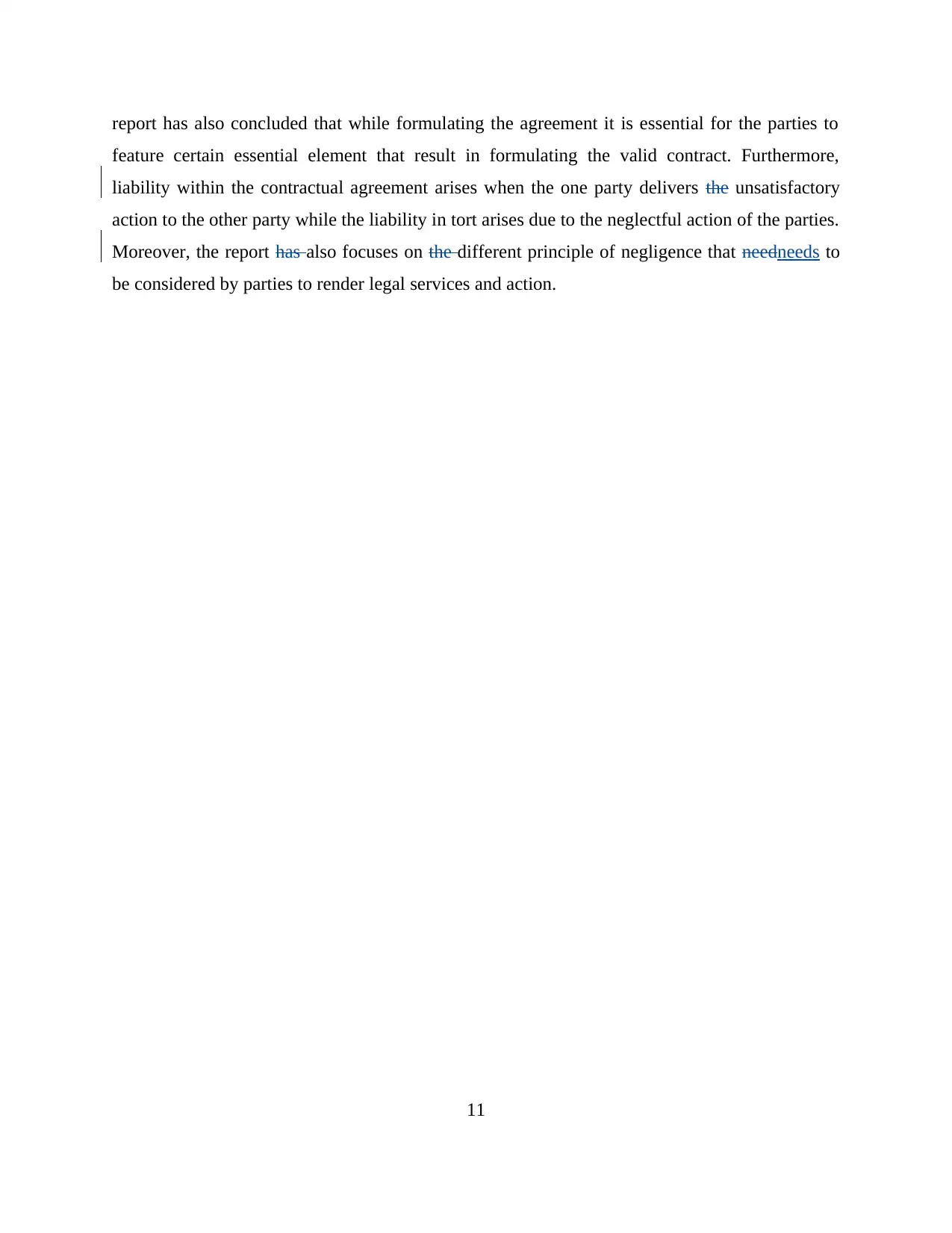
report has also concluded that while formulating the agreement it is essential for the parties to
feature certain essential element that result in formulating the valid contract. Furthermore,
liability within the contractual agreement arises when the one party delivers the unsatisfactory
action to the other party while the liability in tort arises due to the neglectful action of the parties.
Moreover, the report has also focuses on the different principle of negligence that needneeds to
be considered by parties to render legal services and action.
11
feature certain essential element that result in formulating the valid contract. Furthermore,
liability within the contractual agreement arises when the one party delivers the unsatisfactory
action to the other party while the liability in tort arises due to the neglectful action of the parties.
Moreover, the report has also focuses on the different principle of negligence that needneeds to
be considered by parties to render legal services and action.
11
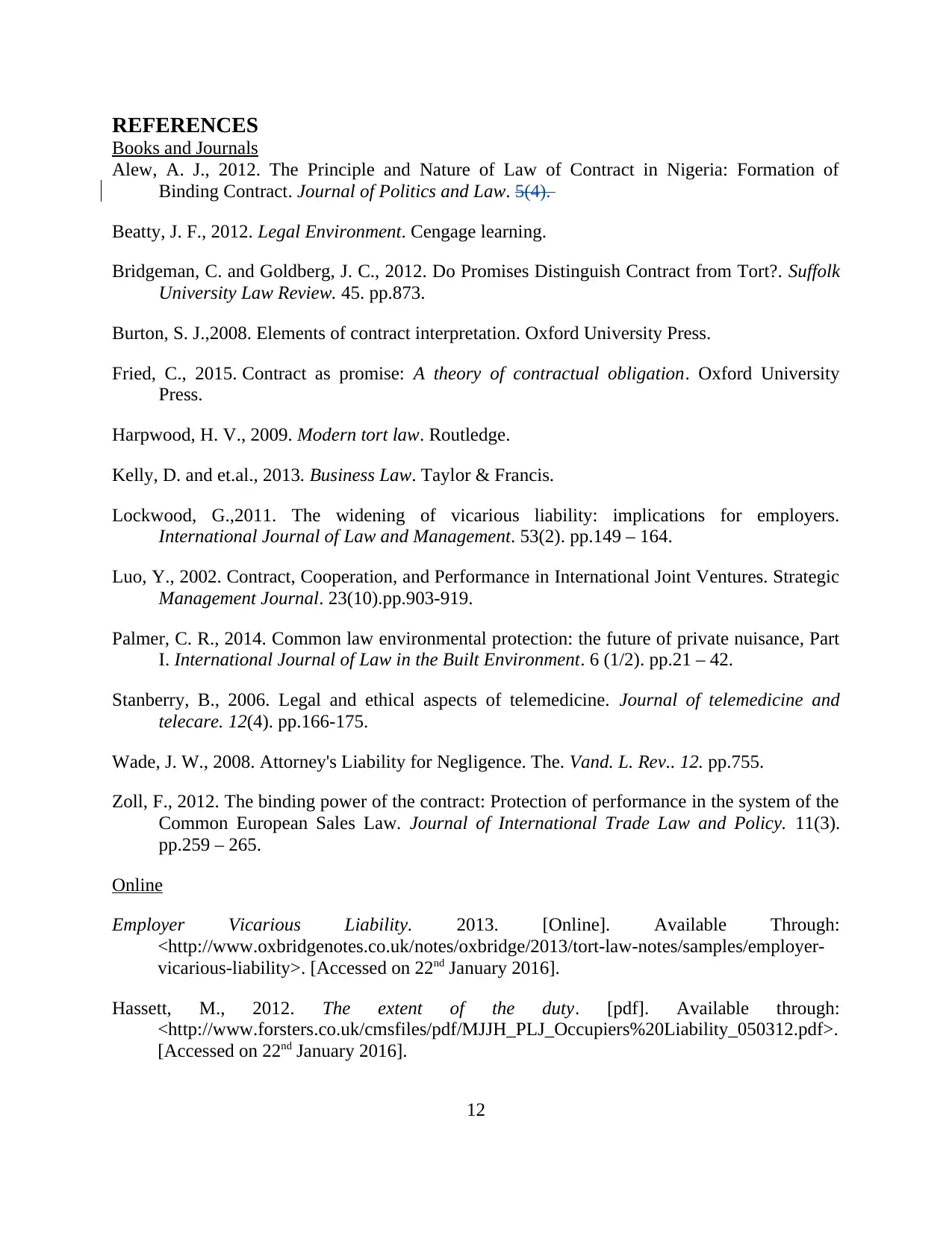
REFERENCES
Books and Journals
Alew, A. J., 2012. The Principle and Nature of Law of Contract in Nigeria: Formation of
Binding Contract. Journal of Politics and Law. 5(4).
Beatty, J. F., 2012. Legal Environment. Cengage learning.
Bridgeman, C. and Goldberg, J. C., 2012. Do Promises Distinguish Contract from Tort?. Suffolk
University Law Review. 45. pp.873.
Burton, S. J.,2008. Elements of contract interpretation. Oxford University Press.
Fried, C., 2015. Contract as promise: A theory of contractual obligation. Oxford University
Press.
Harpwood, H. V., 2009. Modern tort law. Routledge.
Kelly, D. and et.al., 2013. Business Law. Taylor & Francis.
Lockwood, G.,2011. The widening of vicarious liability: implications for employers.
International Journal of Law and Management. 53(2). pp.149 – 164.
Luo, Y., 2002. Contract, Cooperation, and Performance in International Joint Ventures. Strategic
Management Journal. 23(10).pp.903-919.
Palmer, C. R., 2014. Common law environmental protection: the future of private nuisance, Part
I. International Journal of Law in the Built Environment. 6 (1/2). pp.21 – 42.
Stanberry, B., 2006. Legal and ethical aspects of telemedicine. Journal of telemedicine and
telecare. 12(4). pp.166-175.
Wade, J. W., 2008. Attorney's Liability for Negligence. The. Vand. L. Rev.. 12. pp.755.
Zoll, F., 2012. The binding power of the contract: Protection of performance in the system of the
Common European Sales Law. Journal of International Trade Law and Policy. 11(3).
pp.259 – 265.
Online
Employer Vicarious Liability. 2013. [Online]. Available Through:
<http://www.oxbridgenotes.co.uk/notes/oxbridge/2013/tort-law-notes/samples/employer-
vicarious-liability>. [Accessed on 22nd January 2016].
Hassett, M., 2012. The extent of the duty. [pdf]. Available through:
<http://www.forsters.co.uk/cmsfiles/pdf/MJJH_PLJ_Occupiers%20Liability_050312.pdf>.
[Accessed on 22nd January 2016].
12
Books and Journals
Alew, A. J., 2012. The Principle and Nature of Law of Contract in Nigeria: Formation of
Binding Contract. Journal of Politics and Law. 5(4).
Beatty, J. F., 2012. Legal Environment. Cengage learning.
Bridgeman, C. and Goldberg, J. C., 2012. Do Promises Distinguish Contract from Tort?. Suffolk
University Law Review. 45. pp.873.
Burton, S. J.,2008. Elements of contract interpretation. Oxford University Press.
Fried, C., 2015. Contract as promise: A theory of contractual obligation. Oxford University
Press.
Harpwood, H. V., 2009. Modern tort law. Routledge.
Kelly, D. and et.al., 2013. Business Law. Taylor & Francis.
Lockwood, G.,2011. The widening of vicarious liability: implications for employers.
International Journal of Law and Management. 53(2). pp.149 – 164.
Luo, Y., 2002. Contract, Cooperation, and Performance in International Joint Ventures. Strategic
Management Journal. 23(10).pp.903-919.
Palmer, C. R., 2014. Common law environmental protection: the future of private nuisance, Part
I. International Journal of Law in the Built Environment. 6 (1/2). pp.21 – 42.
Stanberry, B., 2006. Legal and ethical aspects of telemedicine. Journal of telemedicine and
telecare. 12(4). pp.166-175.
Wade, J. W., 2008. Attorney's Liability for Negligence. The. Vand. L. Rev.. 12. pp.755.
Zoll, F., 2012. The binding power of the contract: Protection of performance in the system of the
Common European Sales Law. Journal of International Trade Law and Policy. 11(3).
pp.259 – 265.
Online
Employer Vicarious Liability. 2013. [Online]. Available Through:
<http://www.oxbridgenotes.co.uk/notes/oxbridge/2013/tort-law-notes/samples/employer-
vicarious-liability>. [Accessed on 22nd January 2016].
Hassett, M., 2012. The extent of the duty. [pdf]. Available through:
<http://www.forsters.co.uk/cmsfiles/pdf/MJJH_PLJ_Occupiers%20Liability_050312.pdf>.
[Accessed on 22nd January 2016].
12
⊘ This is a preview!⊘
Do you want full access?
Subscribe today to unlock all pages.

Trusted by 1+ million students worldwide
1 out of 13
Related Documents
Your All-in-One AI-Powered Toolkit for Academic Success.
+13062052269
info@desklib.com
Available 24*7 on WhatsApp / Email
![[object Object]](/_next/static/media/star-bottom.7253800d.svg)
Unlock your academic potential
Copyright © 2020–2025 A2Z Services. All Rights Reserved. Developed and managed by ZUCOL.





